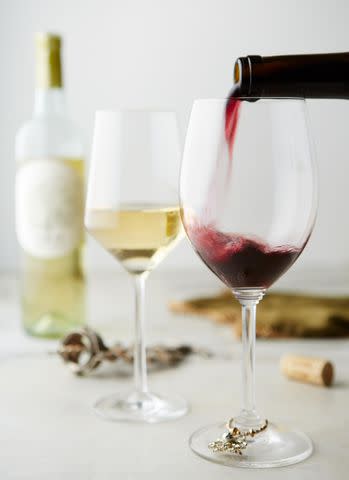Learn the Wine Serving Temperatures for Your Favorite Varietals
To experience the full aroma and flavor of each glass, take note of the best wine serving temperature for each kind of grape.
Selecting wine is only the beginning of serving your guests (and yourself) great wine. What happens between when you buy it and serve it is vital to maximize your enjoyment of that glass of vino. Sure, you know that white wines are served colder than reds, but it's more complex than that. If white wine serving temperature is too cold, the true character, flavor, and aroma will be diminished. If red wine serving temperature is too warm, it will change the balance of the flavor components and deaden the taste.

Think red wine is OK at room temperature? It's actually best if red wine is chilled briefly—10 minutes in the freezer or an ice bucket or 30 minutes in the refrigerator—to bring it to the correct temperature. White wine serving temperature is also cooler than room temp, but it shouldn't be fresh from the fridge if you want to experience all of the flavor notes.
:5 Charitable Causes You Can Support By Drinking Wine
Sparkling, White, Rosè, and Red Wine Storage Temperatures
The optimal sparkling, white, rosè, and red wine storage temperature is around 55°F. Wine ages more quickly if stored at warm temperatures (70°F or so). Fluctuations in temperature are not good for wine either. If you don't have a wine fridge or cellar and plan to enjoy the wine in the near future, try storing both red and white wines in the refrigerator. The chilly temp and lack of moisture might speed up how quickly the cork dries out, but you should be safe if it's a twist top or if you're planning to uncork it within six months or so. Store bottles on their sides to keep the corks from drying out, and place them as far away from the door as possible to keep the wine storage temperature as steady as possible.
It's also important to protect wine bottles from light as much as possible because sun exposure can prematurely age the vino.
Wine Serving Temperature Chart
So what temperature should wine be served at? Read on for the scoop before you uncork your next bottle (or pop open a canned wine).
Champagnes and sparkling wines are best served at 45°F
Light-bodied whites (such as Sauvignon Blancs and Rieslings) are best served at 45° to 55°F
Lighter reds (such as Beaujolais, Pinot Noir, and Grenache) and rosès are best served at 55° to 60°F
Full-bodied whites (such as Chardonnays and Viogniers) are best served at 55° to 65°F
Sauternes are best served at 58° to 62°F
Heavier reds (such as Cabernet Sauvignons, Zinfandels, and Merlots) are best served at 60° to 65°F
Fortified wines (such as port and sherry) are best served at 62° to 65°F
How to Help a Bottle Reach the Best Serving Temperature
If you need to cool your bottle, use any of these options until it is close to the wine serving temperature listed above.
Salty ice bath
Freezer (Set an alarm for 30 minutes or less so you don't put the bottle at risk for an explosion!)
Refrigerator
If you need to raise the temperature of a chilled wine slightly, rinse a decanter with hot water and pour the bottle into the decanter to aerate and warm.
Test Kitchen Tip: Invest in a digital infrared thermometer if you want to be exact about hitting the optimal wine serving temperature.
Now that you are wise to the tastiest wine serving temperature, you're all set to invite all your pals over for a super-casual wine tasting party. (Hey, science says it engages your brain beyond compare!)
false